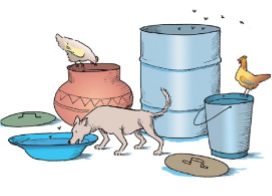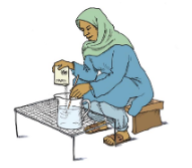Common Questions about Cholera
What are the symptoms of Cholera?
Is there a high risk of getting cholera from other people?
Can a lactating mother with symptoms of cholera transmit it to her baby?
How can I protect myself from cholera?
What is cholera?
Cholera is a waterborne disease, spread by eating food or drinking water that is contaminated with the bacteria called Vibrio cholerae. This bacteria is responsible for causing cholera - an illness characterized by severe diarrhoea and dehydration that can kill within hours if left untreated. The risk of cholera is the highest among the most marginalized populations, where water, sanitation and health related services are at the lowest coverage.
What are the symptoms of Cholera?
The majority of individuals who contract cholera will either have mild symptoms or none at all. However, 1 in 10 people with cholera will experience severe symptoms. It can take between 12 hours to 5 days for symptoms of cholera to show up after eating or drinking contaminated food and water. Cholera can harm both adults and children and can be deadly if not treated quickly. The typical symptoms of cholera are:
- Acute watery diarrhea “rice-water stools” with or without vomiting.
- Severe thirst, sunken eyes, and elastic skin.
- General fatigue.
- Muscle spasms.
How is cholera transmitted?
When people don't have access to clean water and sanitation, there's a higher chance of getting infected with cholera. During an epidemic, the primary source of contamination typically stems from the faeces of an infected individual, which can contaminate water or food sources.

- Consuming contaminated food and water: Cholera is caused when people consume food or water contaminated with cholera bacteria. The bacteria can be found in areas with poor sanitation and hygiene, where human faeces (waste) are not properly disposed of and contaminate water sources.
- Poor hygiene: Cholera bacteria can be transmitted through unwashed hands, in untreated water and raw and leftover foods, and by flies.
Is there a high risk of getting cholera from other people?
Cholera is typically not spread directly from one person to another through casual contact, so the chances of getting sick by being around an infected person are low.
Can a lactating mother with symptoms of cholera transmit it to her baby?
The bacteria that cause cholera are not transmitted through breast milk. Even if the mother shows symptoms of cholera, she should continue breastfeeding her baby. A baby from birth up to 6 months of age who has diarrhoea/cholera, should also be exclusively breastfed.
How is Cholera treated?
For people with mild or no symptoms of cholera, it is important to take Oral Rehydration Solution (ORS) immediately. However, if someone develops severe diarrhoea and vomiting, they must seek medical attention immediately.

- Give oral rehydration solution (ORS): Most people who get cholera can be treated successfully by drinking oral rehydration solution (ORS) as soon as possible. If you use the WHO/UNICEF ORS standard sachet, mix it with one litre (L) of clean drinking water, if you are using another brand, please follow the user guidance of this specific brand. Adults with moderate dehydration may need to drink up to 6 litres of ORS on the first day of treatment.
- Seek medical advice: Cholera can be a serious and potentially life-threatening illness, especially if left untreated. If the patient is critically ill, it is generally advisable to call a doctor or emergency services rather than attempting to transport them to a healthcare facility on your own. This approach helps to prevent the potential contamination of the environment. Read more on how to transfer a patient with cholera.
- Continue giving breast milk: Exclusively breastfed infants rarely develop cholera, unless the vibrio is introduced through the infant’s mouth, which is prevented by exclusive breastfeeding. Using contaminated water while bottle feeding may result in transmission of cholera to infants and young children.
- Giving zinc to under the age of 5: Giving zinc as an additional treatment is important for children under 5 who have cholera. It can help reduce the length of diarrhoea and may even prevent future episodes of acute watery diarrhoea caused by other factors.
How can I protect myself from cholera?
Cholera is preventable and can be stopped from spreading if people at high risk have access to clean water and sanitation facilities; toilets and maintain hygienic condition and practices.
Take water from protected water sources: Using unprotected sources to drink water, brush your teeth or prepare food from rivers, ponds, or wells, can increase the risk of contracting cholera, as these sources may contain harmful bacteria or other germs. Only drink water that has been made safe by boiling or treated with appropriate chlorine tablets.
Use toilets: Do not defecate in the open and use toilets. It is important to focus on safely managing and disposing of excreta. However, it is recommended to avoid emptying latrines or handling faecal waste directly during this period. If latrines must be emptied, take all precautions to avoid contamination during emptying and ensure excreta is disposed of safely. Clean and disinfect toilets and surfaces contaminated with faecal matter, use a soap solution to cleanse the surface and remove any solid waste.
Store water in clean container: To prevent water contamination, store water in a covered container with a tap, narrow neck or with a cover and a dedicated tool for extracting the water so that hands or other objects don't contaminate it.
Wash hands at critical times: Wash your hands with soap and running water before preparing food, eating or feeding a child, after going to the toilet and cleaning a child’s bottom or after taking care of someone who is sick with diarrhoea. If soap is not available, then use ash or an alcohol-based hand rub with at least 60% alcohol.
Wash, cook and cover your food: Eating raw or leftover cooked food can be risky as it may contain harmful bacteria or viruses. Cook the food to reduce the risk of illness and avoid eating raw foods and vegetables and fruits that cannot be peeled. Moreover, utensils should be kept clean with hot water and soap.
How to make your water safe to drink?
- Boil: The simplest and an effective way to make water safe is by boiling. The water should be boiled and remain boiling for at least 10 minutes to make sure all pathogens are killed before use. Before storing the boiled water in clean sanitized containers with tight covers, let the boiled water cool.
- Disinfect: Treat your water with one of the locally available chlorine treatment products and follow the label instructions. If applied correctly, chlorine dioxide tablets can kill germs including Cryptosporidium , a resistant germ. However, iodine, tablets with iodine or chlorine tablets kill most germs, but not Cryptosporidium.
- Use a water filter: There exists a wide range of filter types, in terms of filtering material, filtration processes and shapes/design/usability. Inform yourself well how they work and choose the best one on the market.
Are there vaccines available to prevent cholera?
- There are currently three WHO pre-qualified oral cholera vaccines (meets WHO standard for vaccine quality, safety and efficacy standards); Dukoral®, Shanchol™, and Euvichol®. To be fully protected, all three vaccines require two doses. Shanchol and Euvichol are essentially the same vaccine produced by two different manufacturers and can be administered to individuals over the age of one year.
- Shanchol™ and Euvichol®, require a minimum of two weeks delay between each dose. When two doses are administered, they provide protection against cholera for a duration of three years. Dukoral on the other hand, are given to individuals over the age of two years and requires a minimum of 7 days, and maximum of 6 weeks delay between each dose.
- The availability of these vaccines depend upon the countries. Therefore, visit the nearest health facility, to know more.
Average Rating: ☆ ☆ ☆ ☆ ☆ (0 reviews)


